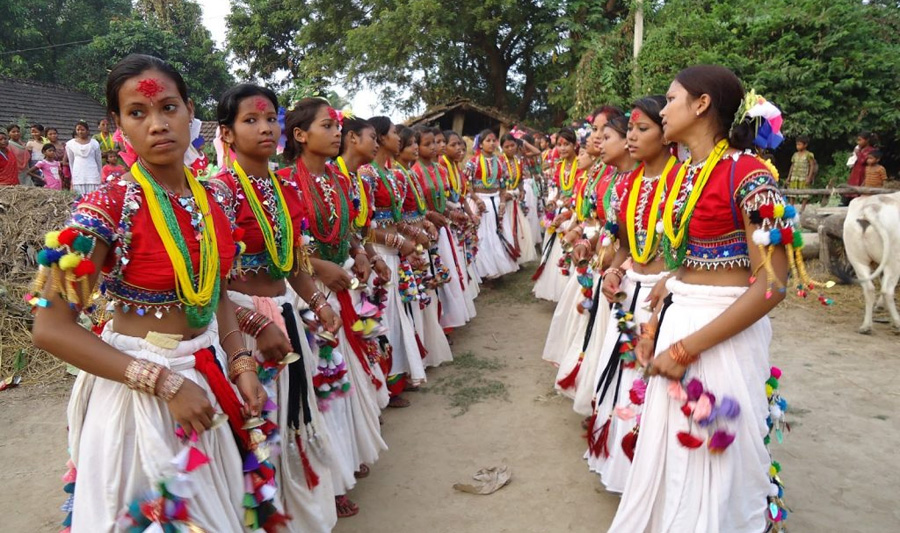Maghi Festival – a cultural Integration
Tharu ethnic community of Kailali and Kanchanpur districts are celebrating the Maghi festival with much fanfare on the 1st Day of Magh ( 15th January). Tharu people celebrate it as the biggest festival in the community. The day is also the community’s New Year which is celebrated for a week. Tharu people clean and decorate their houses to welcome their New Year. On this occasion, they perform Shakiya Naach, a special dance organized during the festival.
Several clubs and social organizations formed in each village form separate cultural teams and perform during the festival. Similarly, locals at Banauli, Khukkad, Bauniya, Tharu Home Stay of Bhada among other places of Gadariya in Kailai organized various cultural programs to mark the day.
Maghi is one of the most major festivals of ethnically, culturally, and religiously diverse Nepal.
On the same day, Tharu people have a tradition to select their leader for the whole year till the next festival. The leader will be leading the community for several social issues like weddings, farming, organizing other festivals,s and so on.
In the past days, even Kamaiyas (bonded laborers) were chosen during the festival, but the tradition no longer exists after the abolishment of the Kamaiya practice, sources say.
Reflecting the social harmony, other than the Tharus also celebrate the festival with equal enthusiasm. Since the day falls on the first day of the month of Magh of Bikram Sambat. The days are celebrated with fun-filled events in other parts of the country.

Special dishes of Maghe Sankranti
In other regions of Hills and Terai, people celebrate the festival by consuming Yam. Yam, which is probably one of the oldest food people might have been consuming since the beginning of human civilization. It verifies the historical background of the festival to have long practice in the region. Besides, “Tillko Laddu” (Brown Sesame seed Fudge), “Chakku” (Malays), “Ghee” (Clarified Butter), “Tilauri”, Spinach and Yam’s curry is cooked as Maghe Sankranti’s special food. Tarul (Yam roots) is very special on this day. It is believed that the foods like Ghiu Chaku, Tilko Laddoo, Spinach, and yam helps us become healthier and warmer during the cold winter.
Meanwhile, some district of the hills celebrates the event by organizing Bullfighting. Sera Bagar of Shivapuri Rural Municipality, Betrawati, and Taruka village of Nuwakot districts are promoting the Bull Fighting event which is organized during Maghe Sankranti. The festival of Maghe Sankranti or Maghi depicts the cultural harmony that integrates Hills and Terai along with the sentiments of people living there.
Astrological Significance
In Sankranti, Sankranti is the first day of all twelve months in the Bikram Sambat Calendar. Sankranti refers to the transmigration of the Sun from one Rashi (a sign of the zodiac) to another. Maghe Sankranti is the transmission of the Sun from Dhanu Rashi (Sagittarius) to Makara Rashi (Capricorn). This day marks the beginning of warmer and longer days. Simply, Makar Sankranti is the end of winter and the beginning of spring.
Early in the morning of Maghe Sankranti, people visit the rivers and major sites like Devghat of Chitwan to take a bath called Makar Snan”. The bath is generally made at tributaries of the rivers (where 3 rivers meet). Kaligandaki, Trishuli, and Kankai river are famous for Makar Snan. The Kankai River in Jhapa is very famous for its holy dip for Makar Snan. People from India also visit these places to take a bath on the day.
Bull Fighting festival
On the occasion of Maghe Sankranti, several places of the hilly region organize Bullfighting programs along with cultural extravaganzas. Shera Bagar and Taruka of Nuwakot are famous for bullfighting. Ten of thousands of locals and tourists visit the site to witness the festival. Bull Fighting is a special attraction of the festival in those places.

One thought on “Maghi – a cultural integration”